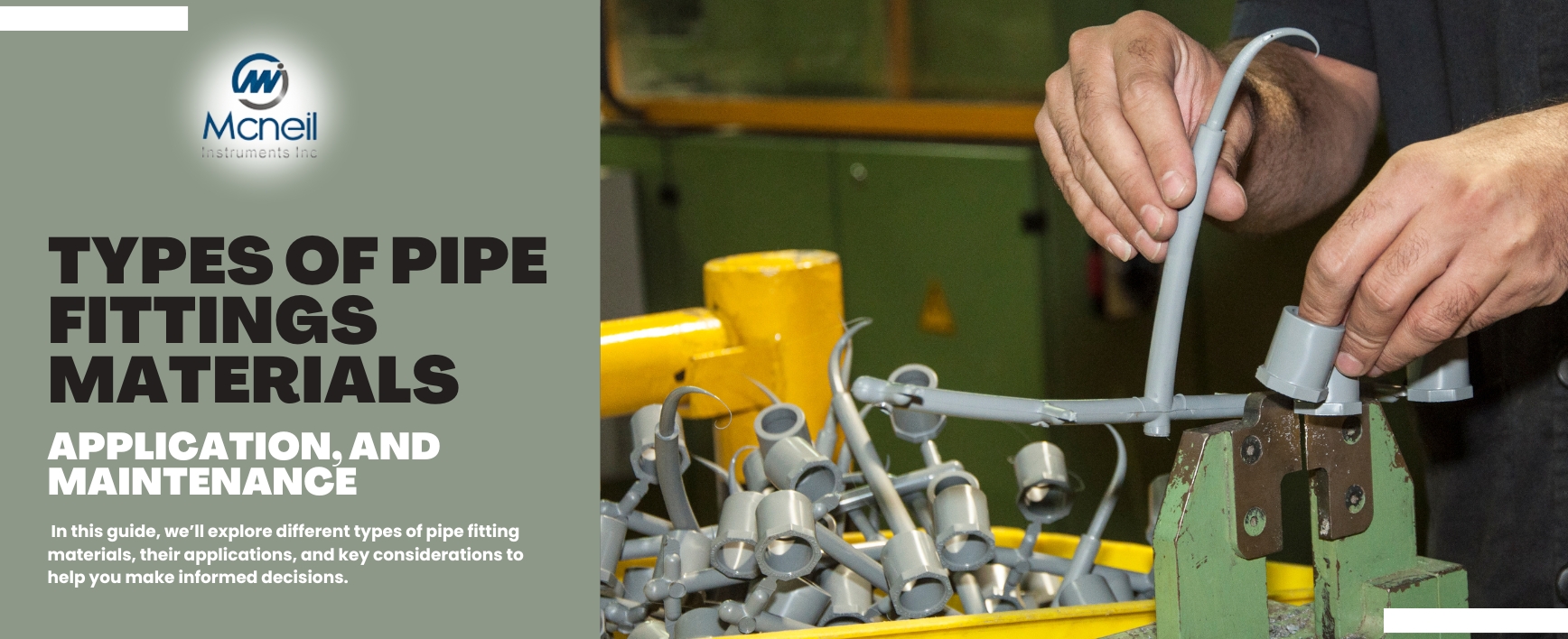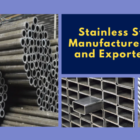Pipe fittings are crucial components in various systems, connecting pipes and enabling the smooth flow of fluids and gases. The choice of material for pipe fittings can greatly affect the durability, performance, and cost of the entire system. In this guide, we’ll explore different types of pipe fitting materials, their applications, and key considerations to help you make informed decisions.
What Are Pipe Fittings?
Pipe fittings are used to connect, redirect, and control the flow of fluids and gases within piping systems. They come in various shapes and sizes, including elbows, tees, reducers, and couplings. Each type of fitting serves a specific purpose, and the material used can impact its performance and suitability for particular applications.
Types of Pipe Fitting Materials
1. Metallic Materials
1.1. Stainless Steel
Stainless steel is a popular choice for pipe fittings due to its excellent corrosion resistance, strength, and aesthetic appeal. It is often used in industries where hygiene and corrosion resistance are critical, such as food processing, pharmaceuticals, and chemical processing.
- Advantages:
- Corrosion Resistance: Stainless steel resists rust and corrosion, making it ideal for harsh environments.
- Strength: It offers high tensile strength and can handle high pressure and temperature.
- Durability: Stainless steel fittings have a long lifespan and require minimal maintenance.
- Applications:
- Food and beverage processing
- Pharmaceutical manufacturing
- Chemical industries
- Marine applications
1.2. Carbon Steel
Carbon steel is another common metallic material used for pipe fittings. It is known for its strength and affordability, making it suitable for many industrial applications. Carbon steel fittings are often used in construction, oil and gas, and water supply systems.
- Advantages:
- Strength: Carbon steel is known for its strength and ability to withstand high pressures.
- Cost-Effective: It is generally less expensive than stainless steel.
- Versatility: Suitable for various applications, including high-temperature and high-pressure environments.
- Applications:
- Construction and infrastructure
- Oil and gas pipelines
- Water and sewage systems
- Power generation
1.3. Brass
Brass is an alloy of copper and zinc, offering good corrosion resistance and machinability. It is commonly used for fittings in residential and commercial plumbing systems.
- Advantages:
- Corrosion Resistance: Brass fittings resist corrosion and are suitable for use in water systems.
- Machinability: Easy to machine and shape, making it suitable for complex designs.
- Aesthetic Appeal: Brass fittings have a polished, attractive appearance.
- Applications:
- Residential and commercial plumbing
- HVAC systems
- Decorative applications
2. Non-Metallic Materials
2.1. PVC (Polyvinyl Chloride)
PVC is a type of plastic commonly used for pipe fittings in water and drainage systems. It is lightweight, durable, and resistant to corrosion and chemicals. Pipe fitting material for PVC is ideal for a range of applications due to its affordability and performance.
- Advantages:
- Lightweight: Easy to handle and install due to its low weight.
- Corrosion Resistance: Resistant to corrosion and chemical damage.
- Cost-Effective: Generally less expensive than metal fittings.
- Applications:
- Water supply and drainage systems
- Irrigation systems
- Chemical processing
2.2. CPVC (Chlorinated Polyvinyl Chloride)
CPVC is a modified form of PVC that can handle higher temperatures. It is often used in hot water systems and applications requiring greater temperature resistance.
- Advantages:
- Temperature Resistance: Can withstand higher temperatures compared to standard PVC.
- Corrosion Resistance: Resists corrosion and chemical damage.
- Ease of Installation: Lightweight and easy to cut and join.
- Applications:
- Hot water supply systems
- Industrial and chemical processing
- Residential plumbing
2.3. PEX (Cross-Linked Polyethylene)
PEX is a flexible plastic material used for pipe fittings in water supply systems. It is known for its flexibility, ease of installation, and resistance to freezing.
- Advantages:
- Flexibility: Can be bent and shaped easily, reducing the need for fittings.
- Resistance to Freezing: Less likely to burst in freezing conditions compared to rigid pipes.
- Durability: Resistant to scale and chlorine, which extends its lifespan.
- Applications:
- Residential water supply systems
- Radiant heating systems
- Plumbing repairs and renovations
Pipe Fitting Material Options
When choosing pipe fitting materials, it’s essential to consider the specific requirements of your application. Here’s a breakdown of various options:
- Stainless Steel: Best for environments requiring high corrosion resistance and strength.
- Carbon Steel: Suitable for high-pressure and high-temperature applications at a lower cost.
- Brass: Ideal for residential plumbing with good machinability and aesthetic appeal.
- PVC: Affordable and versatile, perfect for water supply and drainage.
- CPVC: Handles higher temperatures, making it suitable for hot water systems.
- PEX: Flexible and durable, great for residential plumbing and heating systems.
Pipe Fitting Materials List
Here is a list of common pipe fitting materials:
- Stainless Steel
- Carbon Steel
- Brass
- PVC (Polyvinyl Chloride)
- CPVC (Chlorinated Polyvinyl Chloride)
- PEX (Cross-Linked Polyethylene)
Best Pipe Fitting Materials
The best pipe fitting materials depend on your application’s specific needs. For instance:
- For high-pressure applications: Stainless steel and carbon steel are preferred due to their strength and durability.
- For corrosive environments: Stainless steel and PVC offer excellent corrosion resistance.
- For residential plumbing: Brass, PVC, and PEX are commonly used due to their ease of installation and cost-effectiveness.
Pipe Fitting Materials for High Pressure
In high-pressure applications, the choice of pipe fitting material is critical to ensure safety and performance. Stainless steel and carbon steel are often chosen for their ability to withstand high pressure and extreme conditions. Pipe fitting material specifications for high-pressure systems include factors like tensile strength, yield strength, and pressure rating.
Pipe Fitting Material Specifications
When selecting pipe fitting materials, consider the following specifications:
- Pressure Rating: The maximum pressure the fitting can handle.
- Temperature Rating: The temperature range the material can withstand.
- Corrosion Resistance: The material’s ability to resist chemical and environmental damage.
- Durability: The material’s longevity and maintenance requirements.
Durable Pipe Fitting Materials
Durable pipe fitting materials are essential for long-lasting performance and reliability. Metals like stainless steel and carbon steel offer high durability, while PVC and CPVC provide durability in specific conditions. Choosing a material with a proven track record of durability can help minimize maintenance and replacement costs.
Pipe Fitting Material Comparison
Here’s a brief comparison of various pipe fitting materials:
- Stainless Steel: Excellent corrosion resistance, high strength, and durability.
- Carbon Steel: Strong and cost-effective but prone to corrosion.
- Brass: Good corrosion resistance and machinability; ideal for plumbing.
- PVC: Lightweight, affordable, and resistant to corrosion.
- CPVC: Handles higher temperatures than PVC; suitable for hot water.
- PEX: Flexible, durable, and resistant to freezing.
How to Maintain Pipe Fittings in a Piping Network
To keep pipe fittings in good shape and ensure they work properly, follow these simple maintenance tips:
- Inspect Regularly: Check your fittings often. Look for any signs of damage or leaks, especially where fittings connect to other parts. Catching small issues early can prevent bigger problems later.
- Tighten and Seal: Occasionally, tighten bolts, apply sealants, and replace gaskets to prevent leaks and keep connections secure.
- Protect from Corrosion: Use materials or coatings that resist rust and corrosion to protect your fittings.
- Keep Clean: Regularly clean fittings to remove dirt and debris.
- Flush the System: Periodically flush the piping system to prevent clogs and ensure smooth flow. This helps reduce stress and pressure on the fittings.
- Lubricate When Needed: Some fittings require lubrication. Follow expert advice or the manufacturer’s instructions to know how often to lubricate.
- Don’t Delay Repairs: Address any repairs or replacements as soon as possible to avoid bigger issues.
- Document Everything: For large networks, keep records of installation dates, maintenance, cleaning, repairs, and replacements. This helps track and resolve recurring problems.
Regular monitoring and maintenance of your fittings and piping system will extend their lifespan and keep the system safe and reliable.
Pipe Fitting Material Properties
Understanding pipe fitting material properties helps in selecting the right material for your needs. Key properties to consider include:
- Strength: The material’s ability to withstand internal and external forces.
- Corrosion Resistance: The material’s resistance to chemical and environmental damage.
- Flexibility: How easily the material can be shaped or bent.
- Temperature Tolerance: The range of temperatures the material can handle.
Pipe Fitting Materials in Construction
In construction, pipe fitting materials are chosen for their strength, durability, and ability to withstand environmental conditions. Carbon steel and stainless steel are commonly used for structural applications, while PVC and CPVC are used in plumbing and drainage systems.
Pipe Fitting Materials Guide
This pipe fitting materials guide covers the essential aspects of selecting materials for various applications. Whether you need fittings for high-pressure systems, plumbing, or industrial use, understanding the characteristics and advantages of each material will help you make the best choice.
Instrumental Pipe Fitting Material
When dealing with specialized applications, such as instrumentation and control systems, the choice of instrumental pipe fitting material becomes critical. Materials like stainless steel and brass are often used due to their precision, durability, and ability to handle high-pressure and temperature conditions.
Pipe Fitting Material for PVC
Pipe fitting material for PVC is widely used in water supply, drainage, and chemical processing due to its affordability and resistance to corrosion. PVC fittings are lightweight, easy to install, and offer good performance for a variety of applications.
Choosing the right pipe fitting material is essential for the performance, durability, and cost-effectiveness of your piping system. By understanding the various materials available, their advantages, and their applications, you can make informed decisions that meet your specific needs. Whether you’re working on a residential plumbing project, industrial system, or specialized application, selecting the appropriate materials will help ensure a reliable and efficient system.
For more information on pipe fittings and materials, or to get expert advice tailored to your specific needs, feel free to reach out to industry professionals who can guide you through the selection process.






